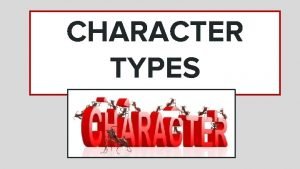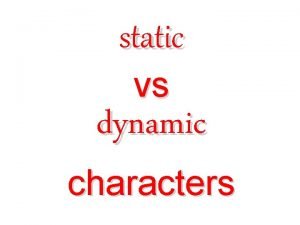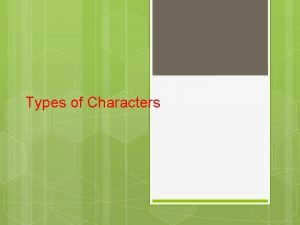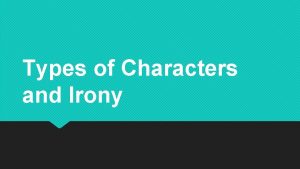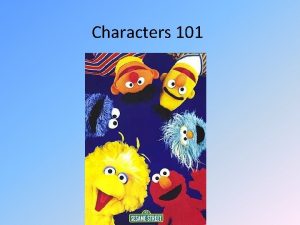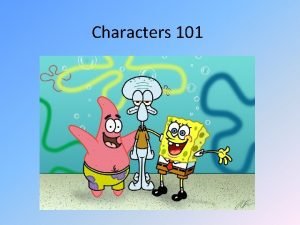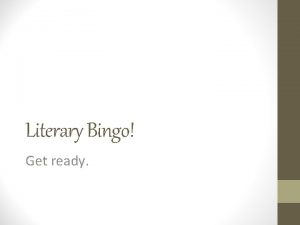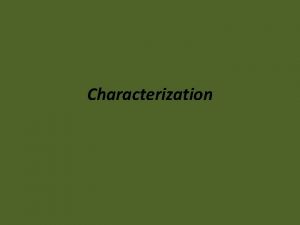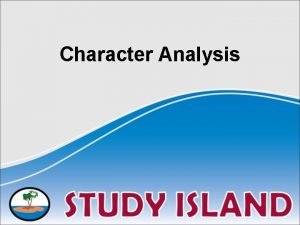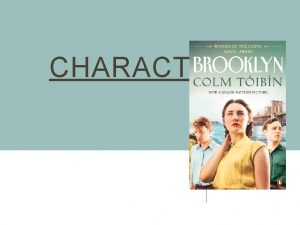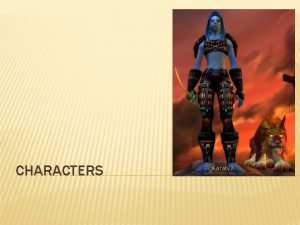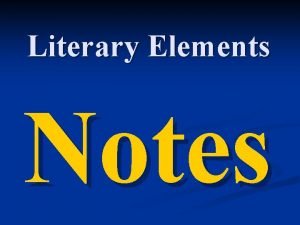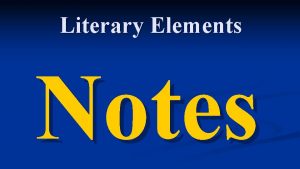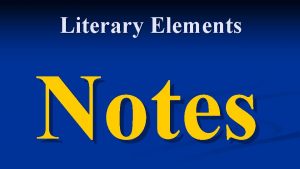Character Analysis Main Characters O Protagonist The main













- Slides: 13

Character Analysis

Main Characters O Protagonist -The main character around whom most of the work revolves. O Antagonist - The person who the protagonist is against. This is often the villain, but could be a force of nature, set of circumstances, an animal, etc.

Protagonists patterns or types: O the anti-hero -This is the guy parents would not want O O their daughters to date. They are often graceless, inept, and actually dishonest. the tragic hero -This is the guy whose bad end is a result of flaws within himself. the romantic hero - This is the guy the girls all swoon over. He gets the girls, even when he doesn’t want to keep them. the modern hero -This is the average guy who is put in extraordinary circumstances and rises to the challenge. the Hemingway hero, This is the guy who has been in a war, drinks too much, and makes poor choices.

Types O Static (unchanging) O Dynamic (changing) O Stereotypical - This is the absent minded professor, the jolly fat person, the clueless blonde.

Round or Flat? O Round (3 dimensional), This means the character has more than one facet to his/her personality. He is not just a hardcore gamer, but he also plays basketball on the weekends. O Flat (1 dimensional), This is the character who is only viewed through one side. This is the hardcore gamer. That’s all there is to the character.

Round character changes during the course of the story O Was the change gradual or rapid? O Was it subtle or obvious? O Are the changes significant to the story or are they a minor counterpoint? O Are the changes believable or fantastic? O What was his/her motivation to change? O What situations or characters encouraged the change? O How does the character learn from or deal with the change?

Major & Minor O Major - These are the main characters. They dominate the story. Often there are only one or two major characters. O Minor - These are the characters who help tell the major character’s tale by letting major characters interact and reveal their personalities, situations, stories. They are usually static (unchanging).

Foils O These are the people whose job is to contrast with the major character. O This can happen in two ways. O One: The foil can be the opposite of the major character, so the major’s virtues and strengths are that much “brighter” in reflection. O Two: The foil can be someone like the major character, with lite versions of the major’s virtues and strengths so that the major comes off as even stronger.

Look for these things within the creation of the character: O Psychological/Personality traits: O Do these characteristics aid in the character being O O consistent (in character), believable, adequately motivated, and interesting? Do the characteristics of the character emphasize and focus on the character’s role in the story’s plot? Motivation: Is the character ethical? Is he/she trying to do the right thing, but going about it in the wrong way? Is the motivation because of emotion (love, hate) or a decision (revenge, promotion)?

O Behavior /Actions: O Does the character act in a certain way consistently? O Or is the character erratic? O Could one pluck the character from the story, put him/her in another story, and know he/she would react? O Relationships: O With other characters in the story O How others see/react to him/her

O Weaknesses/Faults: O Typical tragic weakness is pride. Oedipus is proud. O Weakness could be anything. In “Little Red Riding Hood, ” the girl talks to a stranger. That’s a weakness. O Strengths/Virtues: O There are many different strengths and virtues. O One strength/virtue is being good in trying times, like Cinderella. O Another strength/virtue is caring for family, like Little Red Riding Hood. O Another strength/virtue is being smart, like Oedipus. O Most protagonists have more than one strength/virtue.

Thoughts Backgroun d Actions Feelings

O Using the character analysis terms. How would you describe Montmorency? Cite evidence from the book using quotes with page numbers. O Protagonist Pattern Type O Static or Dynamic O Round or Flat O Stereotypical O Behavior /Actions O Relationships O Weaknesses/Faults O Strengths/Virtues
 What is the theme in the story the lottery
What is the theme in the story the lottery Main vs minor character
Main vs minor character Static/flat character
Static/flat character Hát kết hợp bộ gõ cơ thể
Hát kết hợp bộ gõ cơ thể Slidetodoc
Slidetodoc Bổ thể
Bổ thể Tỉ lệ cơ thể trẻ em
Tỉ lệ cơ thể trẻ em Voi kéo gỗ như thế nào
Voi kéo gỗ như thế nào Tư thế worm breton là gì
Tư thế worm breton là gì Chúa yêu trần thế alleluia
Chúa yêu trần thế alleluia Môn thể thao bắt đầu bằng chữ đua
Môn thể thao bắt đầu bằng chữ đua Thế nào là hệ số cao nhất
Thế nào là hệ số cao nhất Các châu lục và đại dương trên thế giới
Các châu lục và đại dương trên thế giới Công của trọng lực
Công của trọng lực

